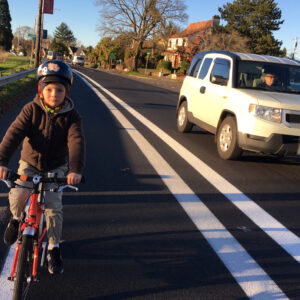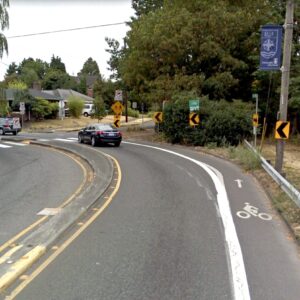If you held out hope for a two-way, off-street path on the bluff side of North Willamette Blvd as part of its upcoming major redesign, I have some bad news.
The Portland Bureau of Transportation has official put that idea to bed. Sometime in the past few weeks, PBOT uploaded a two-page document to the N Willamette Boulevard Active Transportation Corridor Project website that lays out their rationale for abandoning the bi-directional bike lane idea once and for all.
Before I get into that, here’s some context on what I’m talking about…


As I shared in September, PBOT has reached the 30% design milestone on this $6.1 million, federally funded project that will add protected bike lanes, floating bus islands, and much more to a three-mile stretch of N Willamette Blvd from N Rosa Parks Way (in Arbor Lodge) to N Richmond (in St. Johns).
A key section of the route between Rosa Parks Way and University of Portland goes along a bluff overlooking Swan Island. Willamette Blvd is relatively wide in this section and the additional potential right-of-way on the bluff on the south side of the street was alluring enough for some to consider using it for a bi-directional bikeway.
One BikePortland reader even created a mock-up (above) to illustrate his “pipe dream” and got a bit of support for the idea in the comments. One of the main advantages of a two-way facility is that it would be unimpeded by turning drivers or cross-traffic (not to mention the nice views of the river and beyond!).
PBOT was intrigued enough to study the concept more closely. However, in their newly-shared document they outline five reasons why the two-way bikeway, “does not appear to be feasible or desirable.”
PBOT says given the instability of the soil on the bluff and presence of large Sequoia trees, the bikeway would need to be in the main roadway “competing for limited space.” (Note: The current and planned cross-section has two standard lanes and two bike-only lanes.)
And while the lack of cross-traffic has appeal, PBOT points out that the lack of destinations on the bluff side means anyone biking in it would inevitably have to leave it. This would, “Add delays and conflicts compared to [standard] directional facilities,” PBOT says.
Going back to the road width issue, PBOT says there just isn’t enough room for a two-way bikeway and a northwestbound bike lane. “This means that westbound bicyclists on Rosa Parks would have to cross to the south side of Willamette Blvd to enter the two-way bikeway, then would have to cross again to the north side on the other side of the bluff, adding delays, conflicts, and out-of-direction travel to their trips,” the document states.
“Unique design challenges” presented by a two-way facility is another reason PBOT doesn’t like it. They say it’s much easier to deal with things like bus stops when there’s just one direction of travel versus two.
A two-way bikeway on the bluff would also throw a curveball at road users, since it would be inconsistent with the design of rest of the corridor, PBOT says. They prefer to keep designs consistent and that once built, the new protected bike lane on Willamette Blvd will, “most likely Portland’s longest continuous protected bike lanes to date.”
In the end, while we won’t get the off-street path with-a-view experience some folks hoped for, there’s plenty more to be excited about with this project. Learn more about the project here.






Thanks for reading.
BikePortland has served this community with independent community journalism since 2005. We rely on subscriptions from readers like you to survive. Your financial support is vital in keeping this valuable resource alive and well.
Please subscribe today to strengthen and expand our work.
Let’s be real, PBOT will just end up tearing out whatever watered down plan they end up installing anyways
At this point, parking removal seems like a no-go, so it wont get built in the first place.
But there’s no vehicle parking on the bluff side of the roadway, which is one reason the bikeway seemed to fit here.
Not surprising.
We had the odd of this happening to be 2:1
I am not a fan of the two way bikeways that require you to cross traffic twice to enter and exit. The bikeways already feel wide on Wilamette. I’d rather keep them as is then to go down the route being discussed here.
I agree about the crossing. The benefit I think would be that the overall width needed for the bike lane should be less, and that could allow you the space for better protection, like a low curb or whatever. But I think for this tiny section it just isn’t worth the odd crossings.
I feel that pbot has sound reasoning on this issue, even though I think it would be really nice to have a two way bluff side bikeway. But can we please get some hardened infrastructure to protect the bike lanes? And I don’t mean two inch high mountable curbs, ala Rosa Parks, or rounded plastic tough curbs with flexible wands… I’m talking either real grade separation or tall (6 inch+) concrete barriers.
Yeah, I think they’re right. I always think about how nice it would be to have both bike lanes on that side, because you’d get the good view and it’s a nice long section with zero roads or driveways. Seems like a missed opportunity.
But then yeah, you’d have to cross twice and it would just be weird. I think about where you would cross and it’d have to be at that already tight intersection at Rosa Parks which honestly I would almost never want to stop and use every time, I just want to cruise on past. And it’s just an unusual maneuver, to cross two way traffic into the “wrong” side of the road. Not to mention the bus stuff they pointed out as well.
I guess it just doesn’t seem worth it to me. Maybe if it was a much longer stretch.
If you think illegal camping is bad on the bluff now, imagine how much worse it would be when we give that population another swath of easily exploitable public space. Naturally without any guts to protect it.
Hey man, I’m sure you mean well, but what are you talking about? The suggestion would have not changed the size of the road or altered the green space in any way. Maybe read the article before you come grinding an axe that may or may not apply to the article in any way.
I think this is the right call. The 2-way path is appealing and feasible for a short stretch, but connecting to it at either end and along it is not worth the trade-off. PBOT really messed up with their half-baked Greeley path, I am glad to see that they appeared to learn something from that.
What’s half-baked about it? I sincerely want to hear your thoughts.
I hate crossing the road to go downhill, but the goal on Greeley was to keep bikes away from the cars and allow the cars to go as fast as possible, and you have to admit they succeeded at their goal.
Fred,
since you asked, here are my complaints:
I have been commuting daily on Interstate since 2008, the number of bike commuters coming from Greeley shrank dramatically when Hazelnut Grove took over the isolated path as private driveway and bike usage was reduced to basically zero with the redesign. The new design isolate bikes with no escape option in an area that is super isolated at the base of bluff across forma train yard and along a super fast road (average speeds remain at over 55 mph). Allowing cars to drive that fast to appease “freight” makes the repeated crossing of Greeley dangerous and uncomfortable. Not keeping a bollard in place means you never know when you are going to encounter a car on the path either accessing the camp or illegally dumping. I have been threatened by drivers on the path and it is scary. Add to this the fact that PBOT did absolutely zero design to any of the bike connections at Going, at Interstate or along the existing substandard concrete sidewalk and you can see why this is failure. PBOT saw a cheap and easy away to provide the appearance of addressing the dangerous crossing of a bike lane across the 405 on-ramp in a quick and dirty ad hoc retrofit that would make the freight community very happy. All of these design flaws were brought up repeatedly to PBOT to the point that I got an in-person meeting and was old that this was being paid for with freight money and none of these issues would be addressed. PBOT loves to tout the concrete barrier protected bike lane, but they ignore the delays they introduced, the design flaws they chose to ignore, the high speeds that continue to endanger drivers and cyclists, the regular use of the MUP by cars, and the fact that bike commuters have abandoned the route because the design is so bad.
I bike the Greeley path from Rosa Parks to interstate about 3 times a week, and I have never seen any cars ‘blocking’ the path. I also think the diagonal crossing at Going works well (when I’m going southbound, the light almost always changes for me before I stop — and there is no need to carry any momentum into the next section, which is downhill…). There is good access to Interstate via Willamette (just north of Adidas). I agree that getting on Greeley northbound from Interstate sucks, but so does the whole stretch of Interstate (both directions) between Greeley and Rose Quarter. Your complaints telegraph a lot of resentment about car and truck traffic. I share your desire to live someplace with less automobile transport, but that’s how most people get around.
Seems reasonable. I agree that a two-way cycle track would be nice in that area, but it also doesn’t seem necessary if we can upgrade the road to have protected bike lanes.
Seems like a more useful addition to the area would be another trail providing access to Swan Island between Going St and the Waud Bluff trail. But the latter cost $3.2m so that’s probably not happening anytime soon.
When pbot had the chance to be great, they opted to go for mediocre. Because, you know, cars.
Portland: the USA’s most bike-friendly city, where cars always have priority.
Here’s a line that’s not in the report – it’s just implied:
“Users of motor vehicles will always have priority in our current system.”
When eastbound cars turn left, waiting cars turn into the bike lane to pass. Happens all the time. Audacious and dangerous. We need a barrier to prevent this.
The traffic separators should help with this.
It only takes a few minutes to ride that section, I’d rather not have to wait for two new lights. Unless the double lane went all the way from Rosa Parks to St. Johns. Which that could really be something.
But really. Can we just finally get some stripes from the railroad bridge to Richmond without it taking 3 more years?